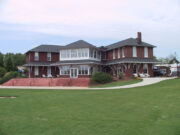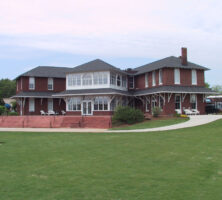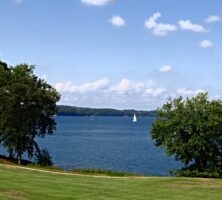Gainesville, the “Queen City of the Mountains,” is located fifty-two miles northeast of Atlanta on Interstate 985, on the shore of Lake Lanier. Lying at the southern edge of the Blue Ridge Mountains, it is a center of economic activity for the northeastern part of the state.
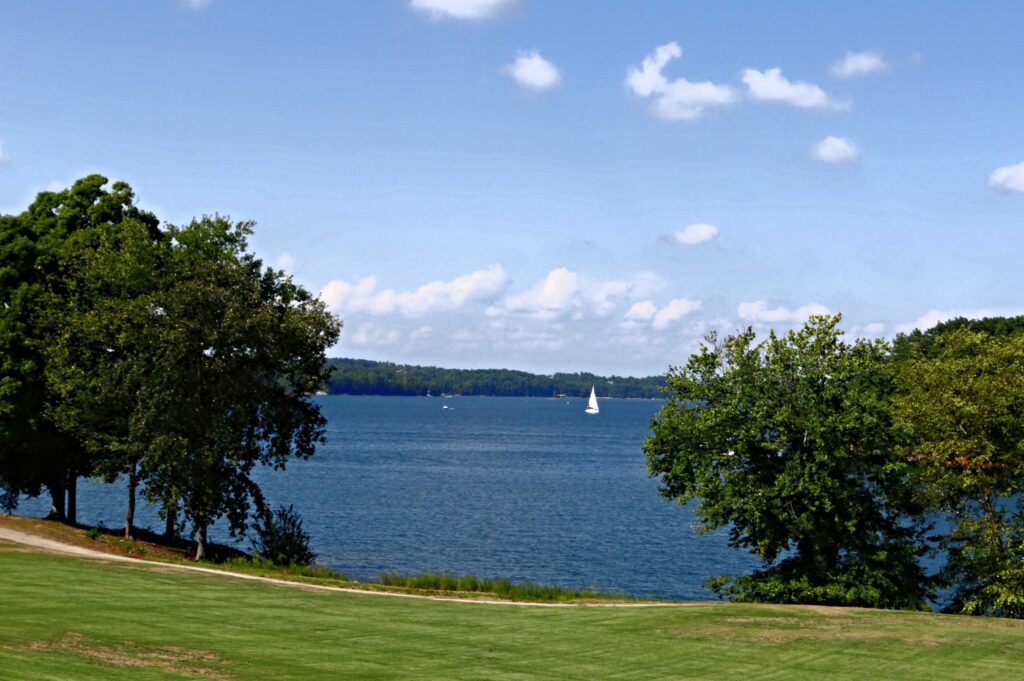
The Nineteenth Century
Chartered in 1821 as the seat of government of Hall County (created in 1818), Gainesville, first known as Mule Camp Springs, began as a collection of houses and stores at a juncture of trade trails dating back to the eighteenth century. The earliest white hunters and traders arrived in a land populated by native Cherokee and Creek nations, whose history in the region preceded that of Europeans by more than a century. English, Scots-Irish, and German newcomers brushed against the fragile, shifting boundaries produced by the uncertain diplomacy of the early national period.
The town was renamed in honor of General Edmund Pendleton Gaines, a hero of the War of 1812 (1812-15) who held a command in Georgia during the ensuing struggles with the Creeks. The discovery of gold near Dahlonega, in adjacent Lumpkin County, in 1828 sealed the fate of the indigenous peoples in northeast Georgia and brought a business boom to Gainesville. Templeton Reid, a Milledgeville silversmith and machinist, established America’s first private mint for gold coins in Gainesville in 1830, creating elusive treasures in the world of coin collectors.
As the gold fever waned, agriculture and livestock grew apace in the area, expanding Gainesville’s service and supply role with hardware, hatters, wagon builders, lawyers, schools, and houses of worship, primarily Baptist, Methodist, and Presbyterian. Gainesville prospered as agricultural activity increased along the rich valleys of the Oconee River and Chattahoochee River, where abundant corn fattened livestock for the citizens’ tables and allowed for homemade production of corn whiskey.
In the late 1850s, as the division between the North and the South deepened, most residents of Gainesville and Hall County were opposed to secession. After Abraham Lincoln’s election to the presidency in 1860, however, sentiment swung decisively in favor of the Confederacy, although pockets of Unionist sentiment remained. Possibly because there were no rail lines into Gainesville at the time, the community escaped the brunt of the Civil War. In 1871 the Airline Railroad, later named the Southern Railroad, connected Gainesville to Athens, Winder, Commerce, and other nearby communities.
Late in the nineteenth century the community claimed ties to significant figures on the state, national, and international levels. Confederate general James Longstreet was appointed postmaster of Gainesville in 1879 and called the town home for almost three decades. In the 1880s future U.S. president Woodrow Wilson’s first wife, Ellen, gave birth to two of their daughters at her aunt’s house in Gainesville. Colonel Allen D. Candler, a Gainesville contractor, builder, and railroad investor, was governor of Georgia from 1898 to 1902.
The Twentieth Century
By the turn of the century Gainesville had become a popular resort town. Electrical power came to Gainesville in 1902, and an electric trolley was soon in operation, providing easy access to Chattahoochee Park, a pavilion built in the late 1890s on the Chattahoochee River, north of the city. Other leisure sites included Limestone Springs, Gower Springs, and White Sulphur Springs. Gainesville’s role as a retreat for lowlanders remained important well into the twentieth century. Meanwhile the expansion of the textile industry in the first quarter of the twentieth century provided most of the large-scale labor opportunity in the region. The once dominant economic influence of Gainesville’s textile industry had all but vanished by the end of the twentieth century.
In January 1903 a devastating tornado struck Gainesville, killing more than one hundred people. But that tragic event was all but forgotten when, on April 6, 1936, one of the nation’s most destructive tornadoes hit the very center of Gainesville, skirting the town square before hitting several neighborhoods and claiming more than 200 lives. A monument to U.S. president Franklin D. Roosevelt, located in the interior yard of Gainesville’s county-municipal complex, commemorates the president’s visits immediately after the tragedy and celebrates the dedication of the 1938 courthouse and city hall.
In the late 1930s a local entrepreneur named Jesse Jewell launched what would become the most important economic endeavor in northeast Georgia: poultry raising, processing, and distribution. By the beginning of World War II (1941-45), chickens had replaced cotton as the area’s leading agricultural moneymaker. By war’s end Gainesville was known as the “Poultry Capital of the World.” Since 1995, the state of Georgia claims that title officially.
The 1953 damming of the Chattahoochee and the creation of the 38,000-acre Lake Lanier resulted in a recreational revolution for the city. By the mid-1950s the Gainesville enjoyed the benefits of the reservoir and a popular recreational site, one of the largest economic forces in the region.
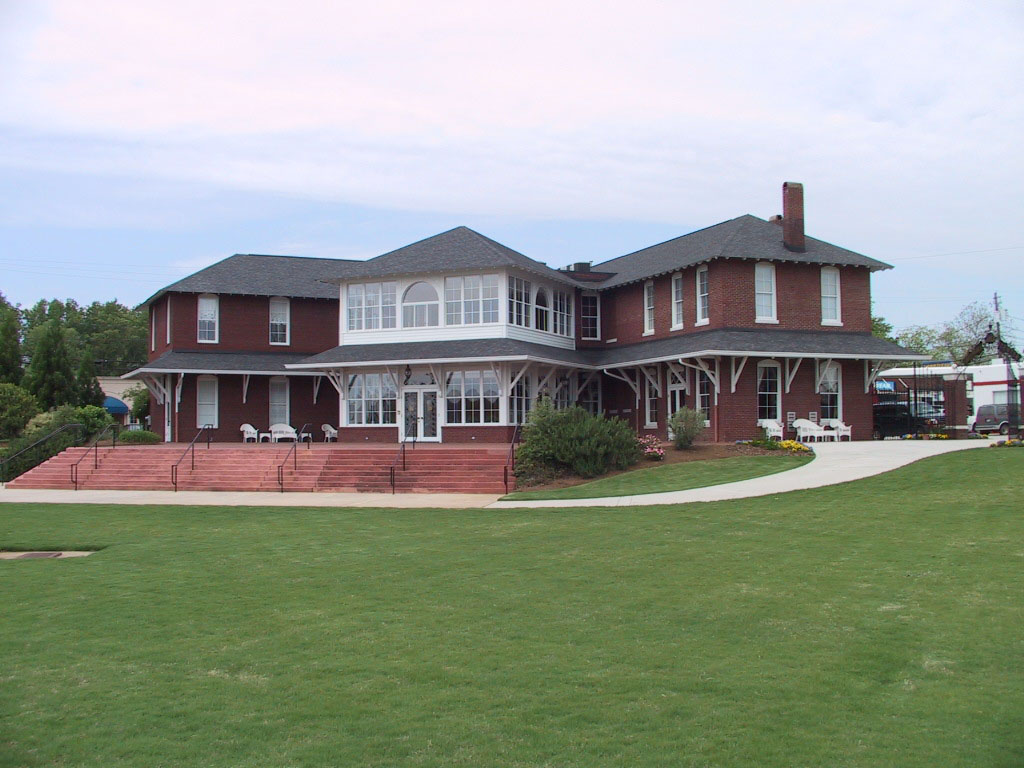
The population of Gainesville doubled between 1990 and 2020, when it reached over 43,000, and in 2020 Hall County was home to over 212,000 people. The Hispanic population, which increased by almost 500 percent in the 1990s, now forms the county’s largest minority group.
Gainesville is a medical, judicial, and financial hub for northeast Georgia. Private and public educational institutions, including Riverside Military Academy, Brenau University, University of North Georgia (formerly Gainesville State College), and Lanier Technical College. The city is home to the Smithgall Arts Center, art galleries at University of North Georgia and Brenau University, and the Quinlan Visual Arts Center. The Gainesville Ballet, Gainesville Orchestra, and other local theater companies benefit from substantial local foundation funding. The Elachee Nature Science Center and the Northeast Georgia History Center attest to the community’s concern for its natural environment and cultural legacy.
The employment opportunities, cultural atractions, and close proximity to the Blue Ridge Mountains, Lake Lanier, and Atlanta make Gainesville one of Georgia’s most favorably situated communities.


